Purchase Behavior According to the Development of Sustainable Pistachio (Pistacia vera L.) Rice Cake: For Korean Consumers
Abstract
1. Introduction
1.1. Perception and Purchase Behavior
2. Materials and Methods
2.1. Participants and Survery Period
2.2. Questionnaire and Statistical Analysis
3. Results
4. Discussions
5. Conclusions
Author Contributions
Funding
Institutional Review Board Statement
Informed Consent Statement
Data Availability Statement
Conflicts of Interest
References
- The Story of Our Rice Cake Made with Sincerity and Shared with Abundance; Rural Development Administration: Jeonju-si, Republic of Korea, 2011; Volume 32, p. 13.
- Park, M.S.; Kim, H.N.; Bahk, G.J. The analysis of food safety incidents in South Korea, 1998–2016. Food Control 2017, 81, 196–199. [Google Scholar] [CrossRef]
- Carneiroa, P.; Kaneene, J.B. Food inspection services: A comparison of programs in the US and Brazil. Food Control 2017, 80, 314–318. [Google Scholar] [CrossRef]
- Weng, X.; Neethiraja, S. Ensuring food safety: Quality monitoring using microfluidics. Trends Food Sci. Technol. 2017, 65, 10–22. [Google Scholar] [CrossRef]
- Liu, Y.; Liu, F.; Zhang, J.F.; Gao, J. Insights into the nature of food safety issues in Beijing through content analysis of an In-ternet database of food safety incidents in China. Food Control 2015, 51, 206–211. [Google Scholar] [CrossRef]
- Qin, J.; Kim, M.S.; Chao, K.; Schmidt, W.F.; Dhakal, S.; Cho, B.-K.; Peng, Y.; Huang, M. Subsurface inspection of food safety and quality using line-scan spatially offset Raman spectroscopy technique. Food Control 2017, 75, 246–254. [Google Scholar] [CrossRef]
- FAO. Sustainable Diets and Biodiversity: Directions and Solutions for Policy, Research and Action; FAO: Rome, Italy, 2012. [Google Scholar]
- FAO. The State of Food Security and Nutrition in the World 2019; FAO: Rome, Italy, 2019. [Google Scholar]
- Kevany, K. Pamela Mason and Tim Lang: Sustainable diets: How ecological nutrition can transform consumption and the food system. Agric. Hum. Values 2017, 35, 743–744. [Google Scholar] [CrossRef]
- Waxman, A. WHO global strategy on diet, physical activity and health. Food Nutr. Bull. 2004, 25, 292–302. [Google Scholar] [CrossRef]
- Kim, S.I.; Park, J.I. Effects of Tteok, Hangwa Image on Consumption Value and Consumer Buying Intention as Dessert. J. Foodserv. Manag. Soc. Korea 2016, 19, 51–74. [Google Scholar]
- Korean Statistical Informations Service Home Page. Available online: http://KOSIS.kr (accessed on 30 December 2022).
- Lee, S.I.; Hong, J.S.; Kim, M.H. A Study on Consumer Awareness and Design concept for the Development of Traditional ‘Tteok’ Products: Using Q Methodology. JCD 2017, 61, 332–349. [Google Scholar]
- Jang, S.O. A Study on Consumer Awareness, Preference, and Consumption Behavior Regarding Rice Cakes: With a Focus on College Students in Busan and the Yeongnam Region. Korean J. Food Cook. Sci. 2014, 30, 547–555. [Google Scholar] [CrossRef]
- Josse, A.R.; Kendall, C.W.; Augustin, L.S.; Ellis, P.R.; Jenkins, D.J. Almonds and postprandial glycemia-a doseresponse study. Metabolism 2007, 56, 400–404. [Google Scholar] [CrossRef] [PubMed]
- Kendall, C.W.C.; Josse, A.R.; Esfahani, A.; Jenkins, D.J.A. The impact of pistachio intake alone or in combination with high-carbohydrate foods on post-prandial glycemia. Eur. J. Clin. Nutr. 2011, 65, 696–702. [Google Scholar] [CrossRef] [PubMed]
- Kendall, C.W..; West, S.G.; Augustin, L.S.; Esfahani, A.; Vidgen, E.; Bashyam, B.; Sauder, K.A.; Campbell, J.; Chiavaroli, L.; Jenkins, A.L.; et al. Acute effects of pistachio consumption on glucose and insulin, satiety hormones and endothelial function in the metabolic syndrome. Eur. J. Clin. Nutr. 2014, 68, 370–375. [Google Scholar] [CrossRef] [PubMed]
- Han, J.A.; Kwon, K.H. Potential Anti-oxidative Properties and Quality Characteristics of Korean Traditional Rice Cake Added with Pistachio (Pistacia vera L.) as Inner Beauty Material. Emir. J. Food Agric. 2022, 34, 1012–1019. [Google Scholar] [CrossRef]
- Xia, K.; Yang, T.; An, L.; Lin, Y.; Qi, Y.; Chen, X.; Sun, D. The relationship between pistachio (Pistacia vera L.) intake and adiposity: A systematic review and meta-analysis of randomized 166 controlled trials. Medicine 2020, 99, e21136. [Google Scholar] [CrossRef]
- Hernández-Alonso, P.; Salas-Salvadó, J.; Baldrich-Mora, M.; Juanola-Falgarona, M.; Bulló, M. Beneficial effect of pistachio consumption on glucose metabolism, insulin resistance, inflammation, and related metabolic risk markers: A randomized clinical trial. Diabetes Care 2014, 37, 3098–3105. [Google Scholar] [CrossRef]
- Sathe, S.K.; Monaghan, E.K.; Kshiesagar, H.; Venkatachalam, M. Chemical composition of edible nut seeds and its implications in human health. In Tree Nuts Composition, Phytochemicals and Health Effects; Alsalvar, C., Shahidi, F., Eds.; Taylor & Francis Group: Boca Raton, FL, USA, 2008; pp. 11–36. [Google Scholar]
- Mandalari, G.; Bisignano, C.; Filocamo, A.; Chessa, S.; Sarò, M.; Torre, G.; Faulks, R.M.; Dugo, P. Bioaccessibility of pistachio polyphenols, xanthophylls, and tocopherols during simulated human digestion. Nutrition 2013, 29, 338–344. [Google Scholar] [CrossRef]
- Huang, H.Y.; Caballero, B.; Chang, S.; Alberg, A.J.; Semba, R.D.; Schneyer, C.R.; Wilson, R.F.; Cheng, T.Y.; Vassy, J.; Prokopowicz, G.; et al. The efficacy and safety of multivitamin and mineral supplement use to prevent cancer and chronic disease in adults: A systematic review for a National Institutes of Health state-of-thescience conference. Ann. Intern. Med. 2006, 145, 372–385. [Google Scholar] [CrossRef]
- Hercberg, S.; Kesse-Guyot, E.; Druesne-Pecollo, N.; Touvier, M.; Favier, A.; Latino-Martel, P.; Briançon, S.; Galan, P. Incidence of cancers, ischemic cardiovascular diseases and mortality during 5-year follow-up after stopping antioxidant vitamins and minerals supplements: A postintervention follow-up in the SU.VI.MAX Study. Int. J. Cancer 2010, 127, 1875–1881. [Google Scholar] [CrossRef]
- Sari, I.; Baltaci, Y.; Bagci, C.; Davutoglu, V.; Erel, O.; Celik, H.; Ozer, O.; Aksoy, N.; Aksoy, M. Effect of pistachio diet on lipid parameters, endothelial function, inflammation, and oxidative status: A prospective study. Nutrition 2010, 26, 399–404. [Google Scholar] [CrossRef]
- Gulati, S.; Misra, A.; Pandey, R.M.; Bhatt, S.P.; Saluja, S. Effects of pistachio nuts on body composition, metabolic, inflammatory and oxidative stress parameters in Asian Indians with metabolic syndrome: A 24-wk, randomized control trial. Nutrition 2014, 30, 192–197. [Google Scholar] [CrossRef] [PubMed]
- US Department of Agriculture. Database for the Oxygen Radical Absorbance Capacity (ORAC) of Selected Foods, Release 2. Nutrient Data Laboratory [Updated May 2010]. Available online: http://www.ars.usda.gov/nutrientdata/ORAC (accessed on 24 February 2012).
- Bolling, B.W.; McKay, D.L.; Blumberg, J.B. The phytochemical composition and antioxidant actions of tree nuts. Asia Pac. J. Clin. Nutr. 2010, 19, 117–123. [Google Scholar] [PubMed]
- Lau, F.C.; Shukitt-Hale, B.; Joseph, J.A. The beneficial effects of fruit polyphenols on juice on cognitive and motor deficits in aging. Nutrition 2006, 22, 295–302. [Google Scholar]
- Umeda, M.; Hiramoto, M.; Watanabe, A.; Tsunoda, N.; Imai, T. Arginine-induced insulin secretion in endoplasmic reticulum. Biochem. Biophys. Res. Commun. 2015, 466, 717–722. [Google Scholar] [CrossRef]
- Alkhatib, A. Antiviral functional foods and exercise lifestyle prevention of Coronavirus. Nutrients 2020, 12, 2633. [Google Scholar] [CrossRef]
- Butler, M.J.; Ruth, M.; Barrientos, R.M. The impact of nutrition on COVID-19 susceptibility and long-term consequences. Brain Behav. Immun. 2020, 87, 53–54. [Google Scholar] [CrossRef]
- Martirosyan, D. The emerging potential of functional foods in viral disease prevention. Funct. Foods Health Dis. 2020, 6, 95–99. [Google Scholar] [CrossRef]
- So, H.Y. Realm of perception. Korean J. Humanit. Soc. Sci. 1977, 1, 125–138. [Google Scholar]
- Cho, M.Y. A Study on Seafood Using Frequency and Consumption Promotion in Elementary School Lunch Program. Master’s Thesis, The Graduate School of Human Enviromental Sciences, Yonsei University, Seoul, Republic of Korea, 2011. [Google Scholar]
- Oakes, M.E.; Slotterback, C.S. Judgements of food healthfulness: Food name stereotypes in adults over age 25. Appetite 2001, 37, 1–8. [Google Scholar] [CrossRef]
- Oakes, M.E.; Slotterback, C.S. What’s in a name? A comparison of men’s and women’s judgements about food names and their nutrient contents. Appetite 2001, 36, 29–40. [Google Scholar] [CrossRef]
- Ronteltap, A.; Sijtsema, S.J.; Dagevos, H.; de Winter, M.A. Construal levels of healthy eating. Exploring consumers’ interpretation of health in the food context. Appetite 2012, 59, 333–340. [Google Scholar] [PubMed]
- Lee, S.B. The Relationships between Corporate Image and Brand Equity: A Comparison of Influence on Brand Attitude and Purchase Intention. Advert. Res. 2007, 76, 97–118. [Google Scholar]
- Park, S.K. Consumer Purchasing Behavior of Knit Fashion Product: Focusing on Shopping Motivation. KSKD 2010, 8, 23–32. [Google Scholar]
- Montano, D.E.; Kasprzyk, D. Theory of reasoned action, theory of planned behavior, and the integrated behavioral model. Health behavior: Theory. Res. Pract. 2015, 70, 231. [Google Scholar]
- Yoon, H.; Yoon, H. A study on the effect of personal consumption values on purchase intention of environment friendly agricultural products: The moderating effect of environmental conscious behavior. Korean J. Hotel Admin 2013, 22, 253–267. [Google Scholar]
- Oh, M.; Park, H.; Lee, S.; Park, S. The effect of well-being lifestyle on perceived value and purchase intention of naturalistic cosmetics. Korean J. Aesthet. Cosmetol. 2010, 8, 175–190. [Google Scholar]
- Min, K.; Hong, W. The Effect of Food Sustainability and the Food Safety Climate on the Job Stress, Job Satisfaction and Job Commitment of Kitchen Staff. Sustainability 2021, 13, 6813. [Google Scholar] [CrossRef]
- Anselmsson, J.; Vestman Bondesson, N.V.; Johansson, U. Brand image and customers’ willingness to pay a price premium for food brands. J. Prod. Brand Manag. 2014, 23, 90–102. [Google Scholar] [CrossRef]
- Joo, J.; Han, Y. An Evidence of Distributed Trust in Blockchain-Based Sustainable Food Supply Chain. Sustainability 2021, 13, 10980. [Google Scholar] [CrossRef]
- Abd Aziz, N.A.; Ramdan, M.R.; Nik Hussin, N.S.; Abdul Aziz, Z.; Osman, J.; Hasbollah, H.R. The Determinants of Global Ex-pansion: A Study on Food and Beverage Franchisors in Malaysia. Sustainability 2021, 13, 10328. [Google Scholar] [CrossRef]
- Lynch, J.G.; Marmorstein, H.; Weigold, M.F. Choices from sets including remembered brands: Use of recalled attributes and prior overall evaluations. J. Cons. Res 1988, 15, 169–184. [Google Scholar] [CrossRef]
- Gluten-Free Products Market by Type, Sales Channel and Geography: Global Trends and Forecasts to 2018. Available online: http://www.marketsandmarkets.com/Market-Reports/gluten-free-products-market-738.html (accessed on 14 February 2016).
- Kadan, R.S.; Phillippy, B.Q. Effect of yeast and bran on phytatedegration and minerals in rice bread. J. Agric. Food Chem. 2007, 57, 643–646. [Google Scholar]
- Kim, J.S. A study on the Consumers’ Preference and Recognition of Processed Food on Yam and Development of Manufactured Products. Ph.D. Thesis, Department of Food Science & Technology Graduate School Yeungnam University, Seoul, Republic of Korea, 2009. [Google Scholar]
- Kim, Y.M.; Park, K.O. An Analysis of Factors Influencing on Temple Foods. Culin. Sci. Hosp. Res. 2016, 22, 240–253. [Google Scholar]
- Beak, H.Y. Consumption of Doenjang and Quality Characteristics of Doenjang Added with Root Vegetable. Ph.D. Thesis, Graduate School Yeungnam University, Gyeongsan, Republic of Korea, 2019. [Google Scholar]
- Kun, K.S. A Study on Influence of the Level of Traditon Fermented Foods’ Quality-Certification to Consuming Consciousness, Purchase Intention and Export Expansion. Master’s Thesis, The Graduate School of Business Administration Kwangwoon Univerity, Seoul, Republic of Korea, 2018. [Google Scholar]
- Choi, S.Y. An Analysis on Effective Factors of Functional Food Purchase Intention Applying an Extended Model of Goal-Directed Behavior. Ph.D. Thesis, The Graduate School Ewha Womans University, Seoul, Republic of Korea, 2017. [Google Scholar]
- Park, C.H. The Effect of Consumption Value of Rice Cake and Korean Food on Purchasing Behavior according to Satisfaction. Master’s Thesis, Graduate School of Tourism & Hospitality Kyonggi University, Seoul, Republic of Korea, 2021. [Google Scholar]
- Shin, Y. The Effect of K-Drama Recognition and Familarity on the Foreigners’ Purchase Intention toward K-Food: Focused on Mediating Effects of Attitude toward K-Food. Ph.D. Thesis, Graduate School of Youngsan University, Gyeongsan, Republic of Korea, 2020. [Google Scholar]
- Lim, E.K. Korean High School Students’ Perception, Preference, and Consumption Behavior to Korean Traditional Rice Cake for Its Popularization. Master’s Thesis, The Graduate School of Education Hanyang University, Seoul, Republic of Korea, 2010. [Google Scholar]
- Min, Y.H. A Research of Gyeongbuk Local Foods and Study on Menu Development Used Local Products: Yugyo, Silla, Ocean, and Gaya Culture Region. Ph.D. Thesis, The Graduate School, Catholic University of Daegu, Gyeongsan-si, Republic of Korea, 2011. [Google Scholar]
- Cho, Y.S. A Study on Recognition, Preference and Popularization of Temple Food. Master’s Thesis, Graduate School of Industrial Management Gyeongju University, Gyeongju-si, Republic of Korea, 2011. [Google Scholar]
- Cappelli, A.; Cini, E. Challenges and Opportunities in Wheat Flour, Pasta, Bread, and Bakery Product Production Chains: A Systematic Review of Innovations and Improvement Strategies to Increase Sustainability, Productivity, and Product Quality. Sustainability 2021, 13, 2608. [Google Scholar] [CrossRef]
- Królak, M.; Górska-Warsewicz, H.; Mądra-Sawicka, M.; Rejman, K.; Żakowska-Biemans, S.; Szlachciuk, J.; Czeczotko, M.; Kwiatkowski, B.; Zaremba, R.; Wojtaszek, M. Towards Sustainable Innovation in the Bakery Sector—An Example of Fibre-Enriched Bread. Sustainability 2022, 14, 2743. [Google Scholar] [CrossRef]
- Osmólska, E.; Stoma, M.; Sagan, A.; Chudzik, B.; Starek-Wójcicka, A. Effect of Supplementation of Freshly Pressed Carrot Juice with Rhus coriaria L. on Changes in Juice Quality. Sustainability 2023, 15, 719. [Google Scholar] [CrossRef]
- Ciudad-Mulero, M.; Morales, P.; Cámara, M.; Fernández-Ruiz, V. Acceptance of New Formulations of Extruded Gluten Free Snacks Based on Pulse Flours by Spanish Millennial Consumers. Sustainability 2022, 14, 3083. [Google Scholar] [CrossRef]
- Kim, C.H.; Lee, J.H. The Study on the Consumers’ Perception and Purchasing Behavior of Rice Cake as a Meal. CSHR 2007, 13, 59–68. [Google Scholar]
- Yoon, H.S. The Study on the Feasibility for Modernization of Traditional Rice Cakes according to Sustainable Dietary Lives—Focusing on Consumers in Cheongju. Master’s Thesis, Korean Traditional Arts Graduate School of Arts Sookmyung Women’s University, Seoul, Republic of Korea, 2009. [Google Scholar]
- Shin, H.R.; Park, S. Importance and Satisfaction of Consumer Selection Attributes and Demand for the Development of Health Premium Seolgitteok. J. Korean Soc. Food Sci. Nutr. 2021, 50, 1137–1144. [Google Scholar] [CrossRef]
- Food Standards and Specifications; Ministry of Food and Drug Safety: Cheongju-si, Republic of Korea, 2020; p. 289.
- Han, J.A.; Kwon, K.H. Importance of application development for Korean rice cake culture succession and adolescent obesity. Prog. Nutr. 2023, 25, e2023004. [Google Scholar]
- Hwang, H.J. Study on the Perception and Purchasing Behavior of Rice Cakes: Focused on Female Consumers. Master’s Thesis, Graduate School of Department of Culinary Food Industry Sejong University, Seoul, Republic of Korea, 2004. [Google Scholar]
- Kim, G.S. Rice Cake Preference and Intake of College Students—Focusing on Daegu Region. Master’s Thesis, Graduate School of Environment & public Health Studies Yeungnam University, Seoul, Republic of Korea, 2010. [Google Scholar]
- Lim, H.R.; An, S. Intention to purchase wellbeing food among Korean consumers: An application of the Theory of Planned Behavior. Food Qual. Prefer. 2021, 88, 104101. [Google Scholar] [CrossRef] [PubMed]
- Wang, J.; Pham, T.L.; Dang, V.T. Environmental Consciousness and Organic Food Purchase Intention: A Moderated Mediation Model of Perceived Food Quality and Price Sensitivity. Int. J. Environ. Res. Public Health 2020, 17, 850. [Google Scholar] [CrossRef] [PubMed]
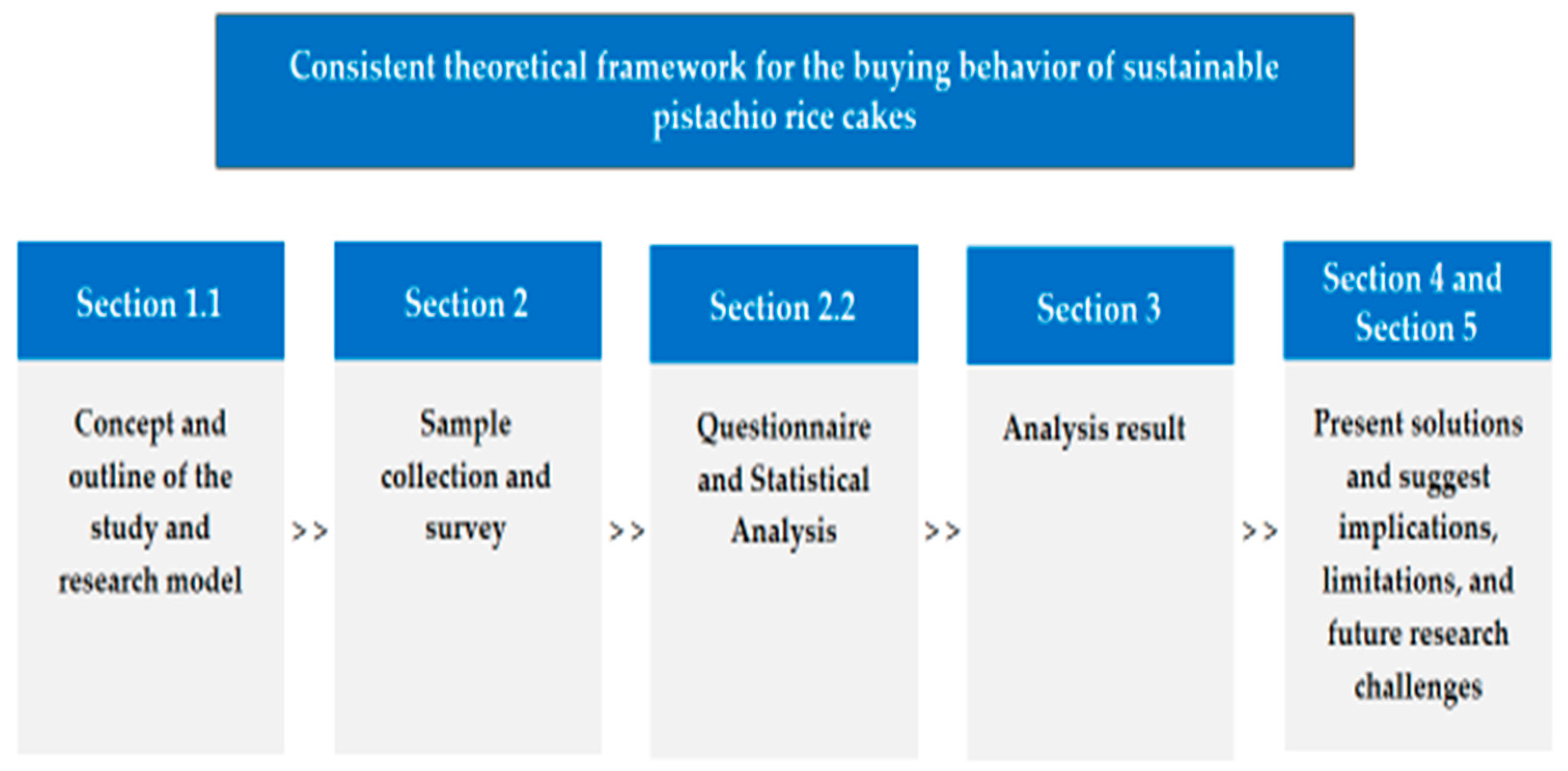
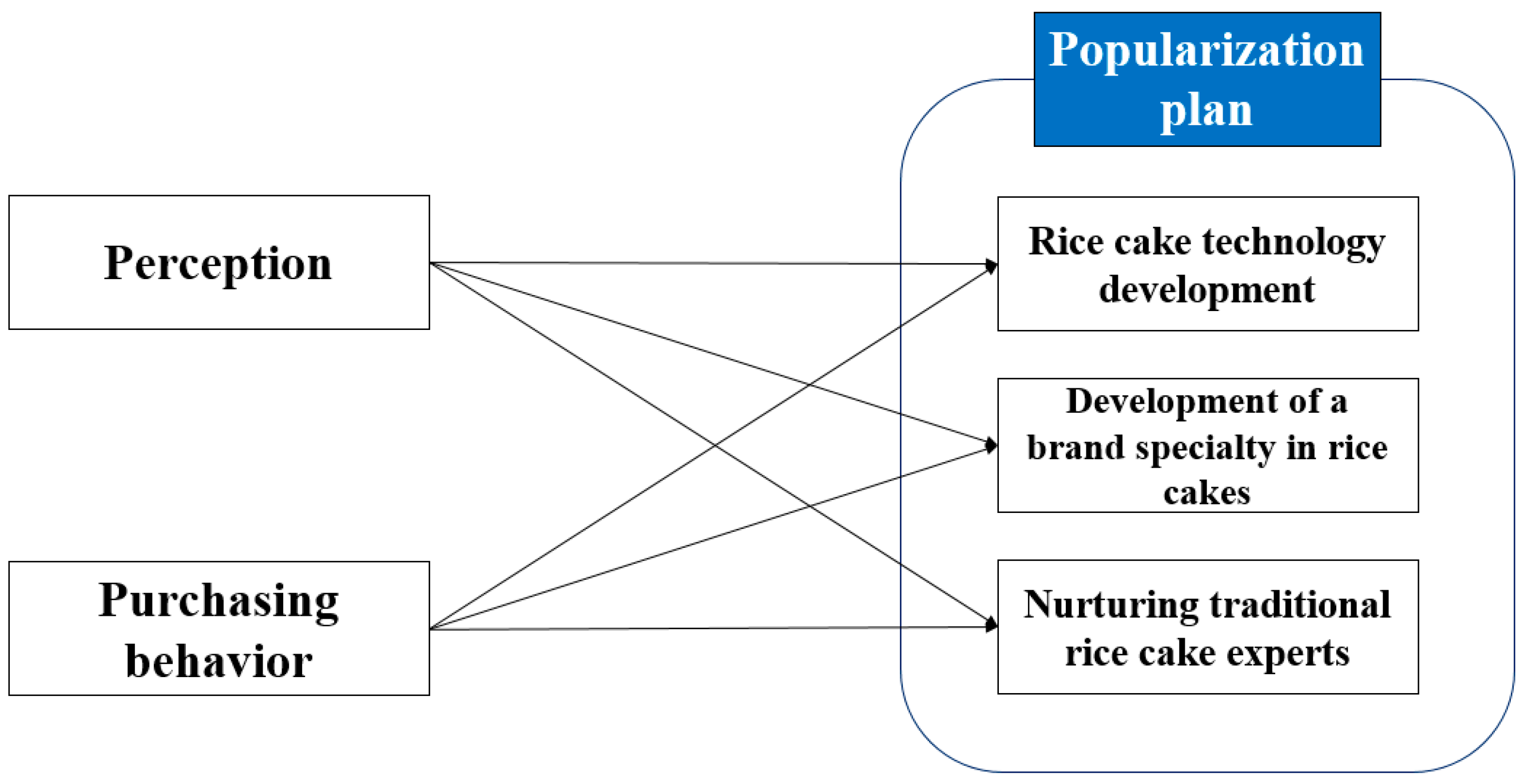
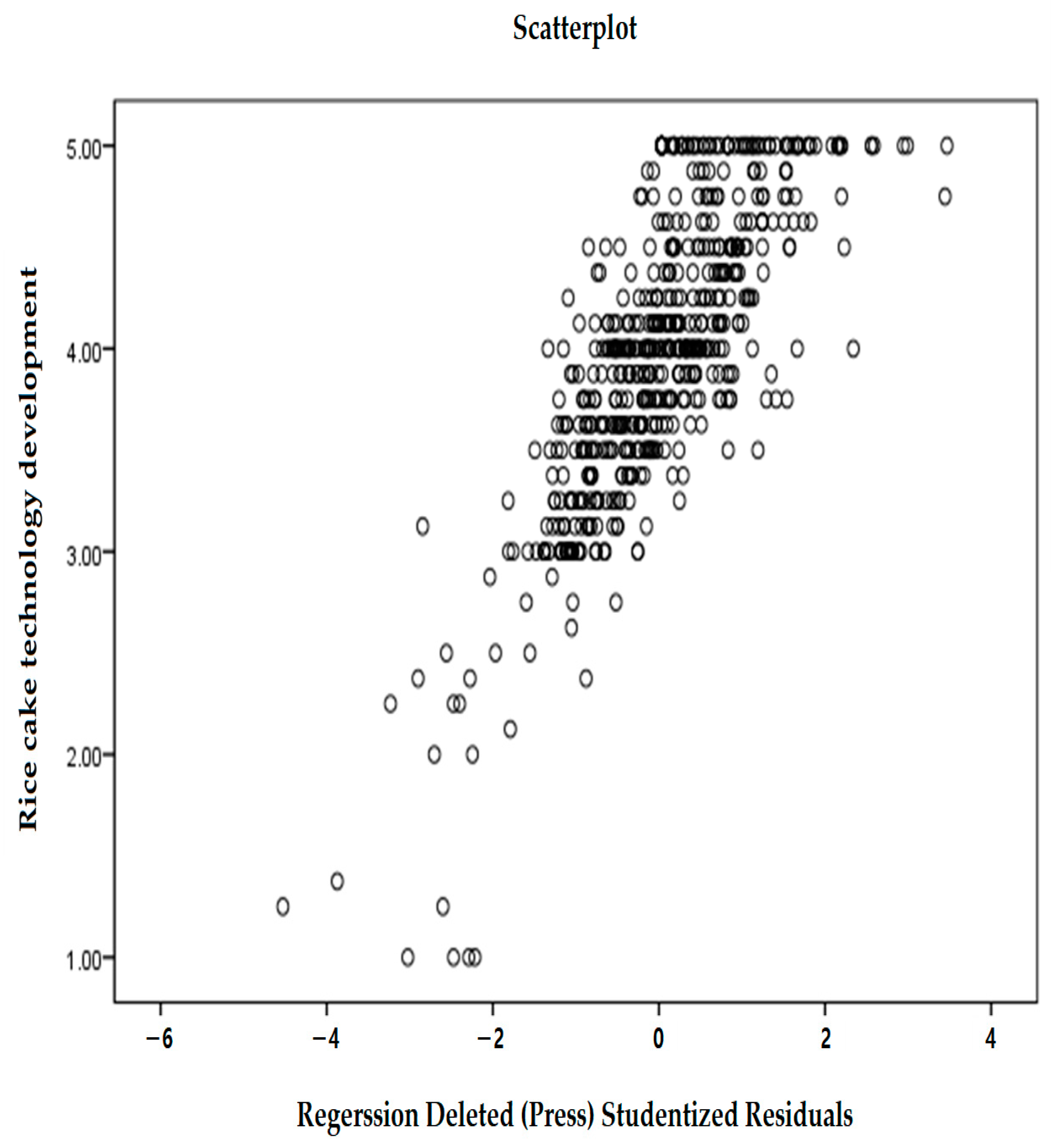
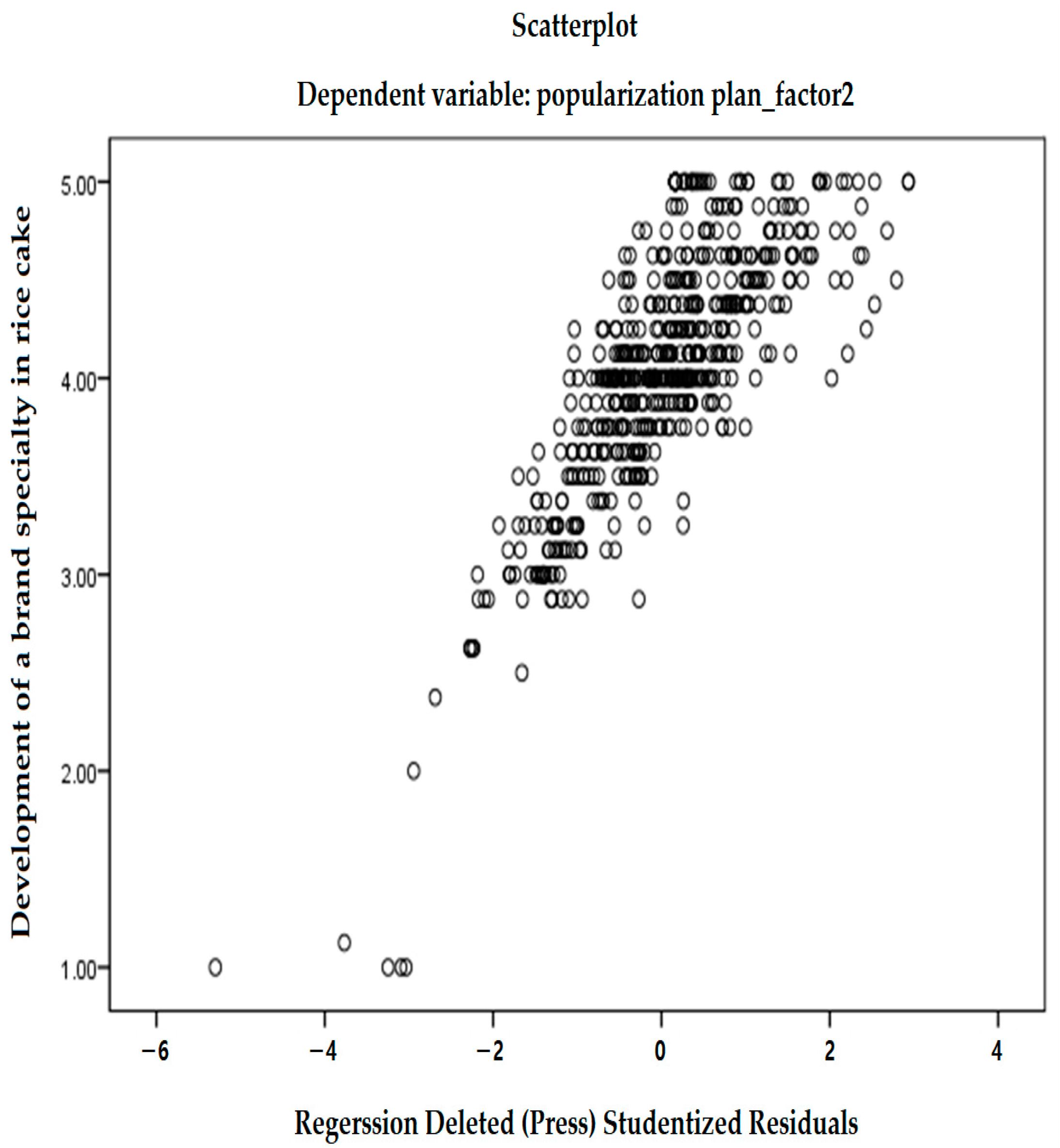
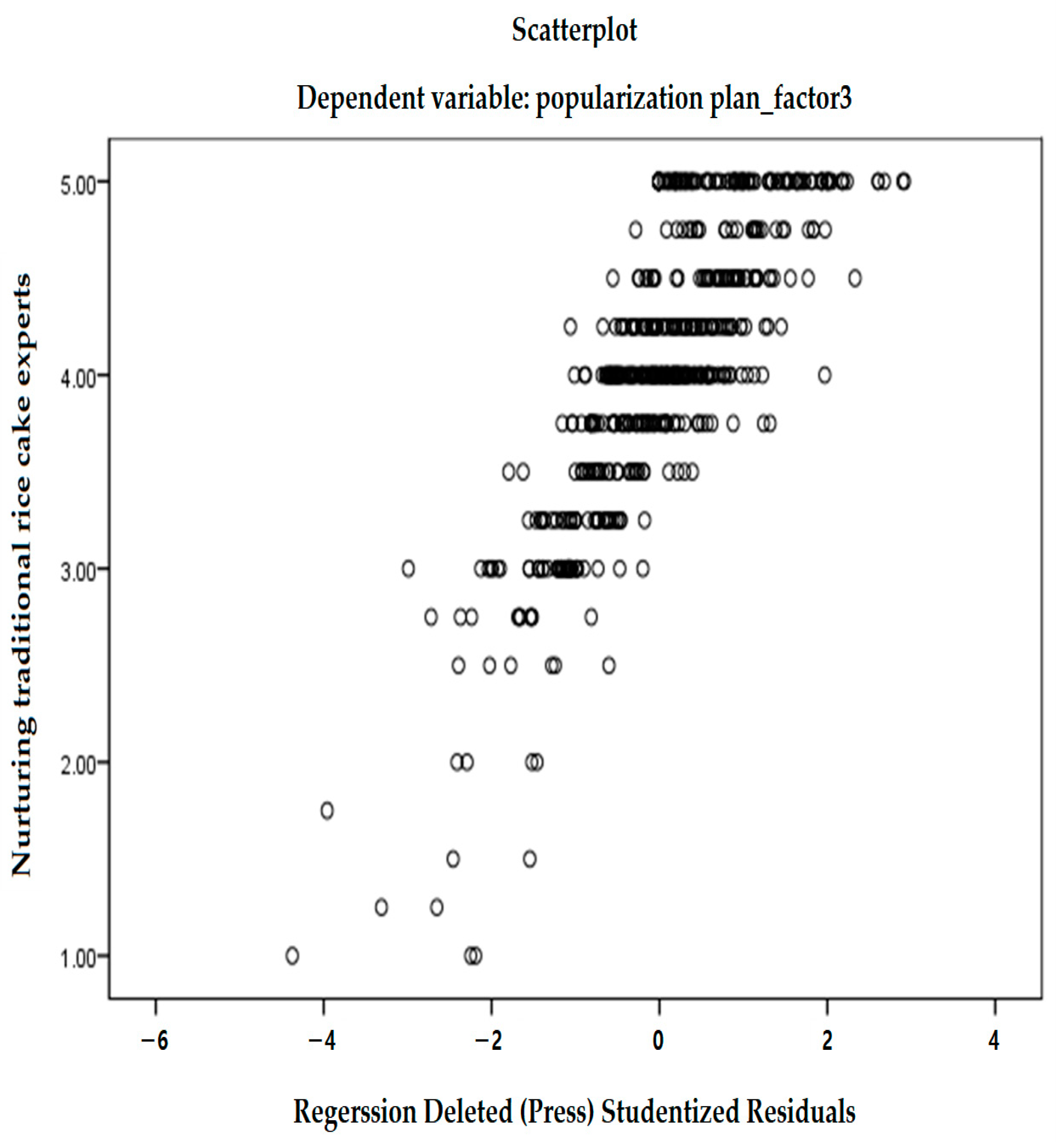
| Division | Item | N (%) |
|---|---|---|
| Gender | Man | 352 (61.1) |
| Female | 224 (38.9) | |
| Marital Status | Single | 345 (59.9) |
| Married | 207 (35.9) | |
| Divorce, widowed, etc. | 24 (4.2) | |
| Age | 20′s | 188 (32.6) |
| 30′s | 199 (34.5) | |
| 40′s | 60 (10.4) | |
| 50′s | 84 (14.6) | |
| 60′s | 45 (7.9) | |
| Education | Less than high school | 134 (23.3) |
| Graduated from junior college | 97 (16.8) | |
| University graduate | 256 (44.4) | |
| Graduate school or higher | 89 (15.5) | |
| Job | Housewife | 37 (6.4) |
| Student | 64 (11.1) | |
| Profession | 145 (25.2) | |
| Technical job | 48 (8.3) | |
| Public official | 25 (4.3) | |
| Service industry | 80 (13.9) | |
| Self-employment | 66 (11.5) | |
| Unemployment | 18 (3.1) | |
| Etc. | 93 (16.1) | |
| Average monthly income | Less than 1 million won | 75 (13.0) |
| More than 1 million won—less than 2 million won | 45 (7.8) | |
| More than 2 million won—less than 3 million won More than 3 million won—less than 4 million won More than 4 million won—less than 5 million won | 164 (28.5) 136 (23.6) 49 (8.5) | |
| Over 500 million won | 107 (18.6) | |
| Total | 576 (100.0) |
| Factor Name | M | SD | Skewness | Kurtosis |
|---|---|---|---|---|
| Perception | 3.68 | 0.63 | −0.31 | 2.15 |
| Purchase behavior | 3.38 | 0.78 | −0.25 | 0.54 |
| Popularization plan | 3.99 | 0.63 | −0.95 | 2.61 |
| 4.02 | 0.66 | −0.86 | 2.02 | |
| 3.97 | 0.72 | −0.73 | 1.50 | |
| All | 3.99 | 0.62 | −0.88 | 2.66 |
| Division | 1 | 2 | 3 | 4 | 5 | |
|---|---|---|---|---|---|---|
| 1. Perception | 1 | |||||
| 2. Purchase behavior | 0.582 ** | 1 | ||||
| Popularization plan | 3. Rice cake technology development | 0.536 ** | 0.556 ** | 1 | ||
| 4. Development of a brand specialty in rice cake | 0.533 ** | 0.597 ** | 0.812 ** | 1 | ||
| 5. Nurturing traditional rice cake experts | 0.487 ** | 0.552 ** | 0.684 ** | 0.818 ** | 1 | |
| Dependent Variable | Independent Variable | Non-Standardized Coefficient | Standardization Coefficient | t | VIF | R2 | F | |
|---|---|---|---|---|---|---|---|---|
| B | S.E. | β | ||||||
| Rice cake technology development | (A constant) | 1.793 | 0.126 | 14.272 *** | 0.375 | 173.555 *** | ||
| Perception | 0.323 | 0.041 | 0.322 | 7.949 *** | 1.512 | |||
| Purchase behavior | 0.298 | 0.033 | 0.368 | 9.081 *** | 1.512 | |||
| Dependent Variable | Independent Variable | Non-Standardized Coefficient | Standardization Coefficient | t | VIF | R2 | F | |
|---|---|---|---|---|---|---|---|---|
| B | S.E. | β | ||||||
| Development of a brand specialty in rice cake | (A constant) | 1.677 | 0.129 | 12.999 *** | 0.407 | 197.997 *** | ||
| Perception | 0.296 | 0.042 | 0.280 | 7.101 *** | 1.512 | |||
| Purchase behavior | 0.370 | 0.034 | 0.434 | 10.988 *** | 1.512 | |||
| Dependent Variable | Independent Variable | Non-Standardized Coefficient | Standardization Coefficient | t | VIF | R2 | F | |
|---|---|---|---|---|---|---|---|---|
| B | S.E. | β | ||||||
| Nurturing traditional rice cake experts | A constant | 1.636 | 0.147 | 11.113 *** | 0.344 | 151.819 *** | ||
| Perception | 0.289 | 0.048 | 0.252 | 6.060 *** | 1.512 | |||
| Purchase behavior | 0.375 | 0.038 | 0.405 | 9.762 *** | 1.512 | |||
Disclaimer/Publisher’s Note: The statements, opinions and data contained in all publications are solely those of the individual author(s) and contributor(s) and not of MDPI and/or the editor(s). MDPI and/or the editor(s) disclaim responsibility for any injury to people or property resulting from any ideas, methods, instructions or products referred to in the content. |
© 2023 by the authors. Licensee MDPI, Basel, Switzerland. This article is an open access article distributed under the terms and conditions of the Creative Commons Attribution (CC BY) license (https://creativecommons.org/licenses/by/4.0/).
Share and Cite
Han, J.A.; Kwon, K.H. Purchase Behavior According to the Development of Sustainable Pistachio (Pistacia vera L.) Rice Cake: For Korean Consumers. Sustainability 2023, 15, 7608. https://doi.org/10.3390/su15097608
Han JA, Kwon KH. Purchase Behavior According to the Development of Sustainable Pistachio (Pistacia vera L.) Rice Cake: For Korean Consumers. Sustainability. 2023; 15(9):7608. https://doi.org/10.3390/su15097608
Chicago/Turabian StyleHan, Ji Ahn, and Ki Han Kwon. 2023. "Purchase Behavior According to the Development of Sustainable Pistachio (Pistacia vera L.) Rice Cake: For Korean Consumers" Sustainability 15, no. 9: 7608. https://doi.org/10.3390/su15097608
APA StyleHan, J. A., & Kwon, K. H. (2023). Purchase Behavior According to the Development of Sustainable Pistachio (Pistacia vera L.) Rice Cake: For Korean Consumers. Sustainability, 15(9), 7608. https://doi.org/10.3390/su15097608







